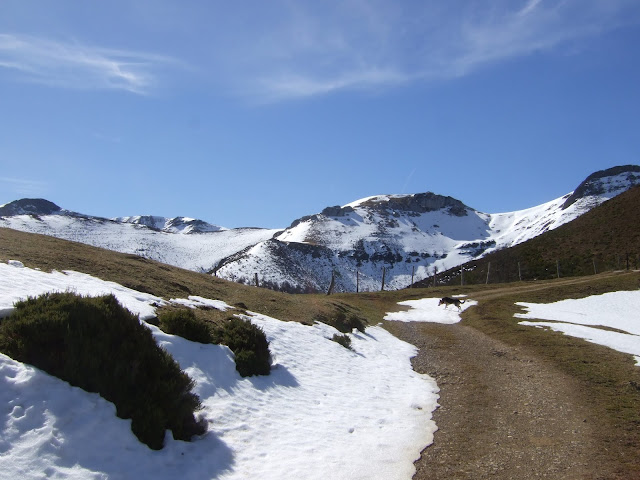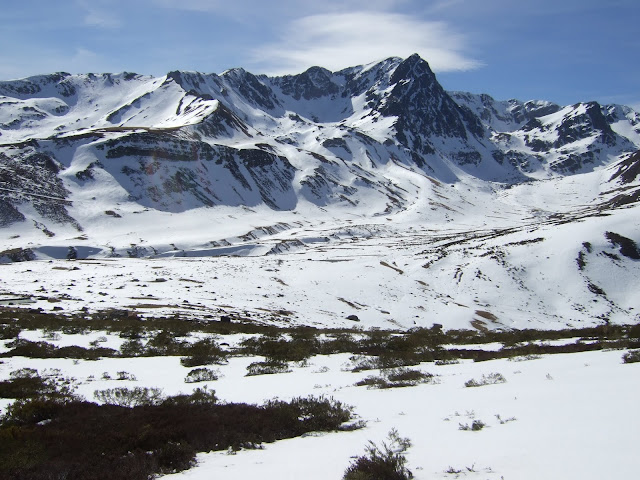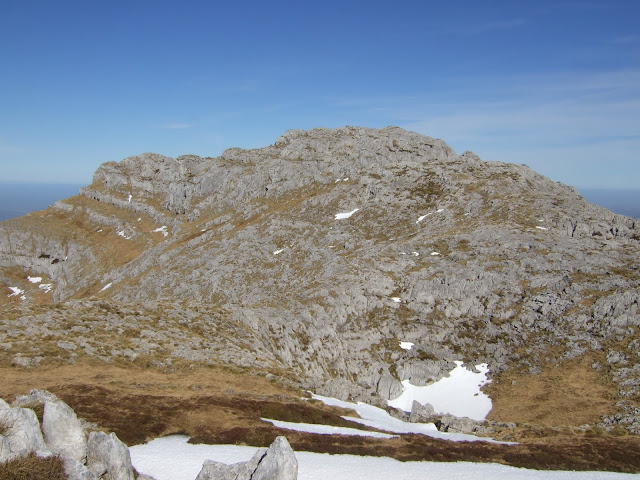En la foto Peña Rocías y Mortillano a la izquierda y Porracolina hacia el centro (sacada de Peña Cabarga un día de sur). Siempre me arrepentí de no haber subido la Porra de La Rasa, que se ve a la derecha de la Porra de Mortillano cuando estuve allí hace unos años. Cuando me enteré de una ruta alternativa a la cima en seguida me animé a hacerla. La subida corresponde más o menos con la pendiente que baja desde La Rasa hacia Peña Lavalle (según se ve en la foto).
From Peña Cabarga, near Santander, looking towards Mortillano (the left third of the photo) and Porracolina (centre).
Dejé el coche en el aparcamiento de la km 7 de la CA-265 que sube de Asón a los Collados. Hay que bajar 500 metros por la carretera. Se veía la cascada más arriba.
There's a small car park 7 kms from Arredondo on the road up to the Collados del Asón. From there I walked 500 metres down the road. The famous Asón waterfall can be seen further on up.
Aquí empieza la ruta, en el km 6,5. Hay una pintada en la roca para indicarla.
Here's where the path up the side of the mountain starts. A spot of yellow paint marks the spot.
Se sube por un encinar precioso
The path goes past lovely holm oaks
A eso de los 650 m perdí el sendero - tendría que haber ido más hacia la derecha- pero seguí hacia arriba hasta llegar a esta roca, que rodeé hacia el N...
After ascending about 250 metres my path ran out - I should have gone more to the right - but I carried on up the hillside till I got to this rockface, and carried on round to the north.
...para encontrar esta zona un poco incómoda, pero no tardé mucho en cruzarla hacia arriba y llegué a la parte que no está en sombra. Desde allí era fácil subir a la derecha
Not the most comfortable terrain, but it didn't take long to get across it and up to the right where the lack of shade indicates a way up round the rockface
casi lo primero que se ve es esta encina grande (750m). La retraté con Porracolina detrás
Almost the first thing you see once you're up is this holm oak. Behind it is Porracolina
Hacia el NE sube lo que parecía una autovía en comparación la senda que había seguido antes
Looking in the other direction, the way up is easy going in stark contrast to the previous uneven rocky ground
Detrás está Peña Lusa
Peña Lusa is behind
Llegé a un hayal, pero antes había visto hacia la derecha el paso que hay que subir para superar el murallón
I reach a beech wood, but on the way up to it I'd seen the pass I'd have to head for over to the right
El sendero continúa subiendo momentáneamente hacia el NE pero pronto cambia de dirección hacia la derecha. Luego hay sendas de animales, y bajé hasta 900m para evitar el roquedo. Luego se puede ir subiendo hacia el farallón. Hay que llegar al Portillo de Allués, que está en el centro de la foto, con varios hayas creciendo en la brecha
The path carries on briefly up to the NE but then changes direction and goes to the right. There are a few paths used by horses and I had to go down to about 900 mts to go round more rocks. Thereafter it's easier to go up the hillside towards the cliff. You have to get to the pass in the centre of the photo; as you get nearer you see there are several beech trees lining the gap between the rocks.
Llego a las cabañas derruidas de Allués. Al otro lado del Asón está la Porra de la Colina, el barranco de Rolacía y Porracolina
I reach the abandoned huts in a place called Allués.
Muy cerca de la entrada del Portillo, donde el sendero se hace menos evidente me encontré con esta rama de haya - el problema es que no la vi, y di contra ella con la cabeza. No recuerdo un impacto así que me haya tumbado en el suelo antes. Quizás hay una continuación del sendero más arriba, a la izquierda, pero trepando por las rocas se subía fácilmente hacia el paso.
Very near to the foot of the pass, the path is less obvious and I walked straight into this branch, ending up on the ground wondering what the hell had happened! There may be a path up to the left that I missed, but in any case it wasn't difficult to climb up the rocks and find the path up through the pass.
Los buitres nos esperaban a la salida
A group of vultures waited above the way out
Al llegar arriba veía el Mazo Grande hacia el sur
At the top of the pass Mazo Grande appeared to the south
Debajo está Allués
Allués can be seen below
La continuación desde un poco más arriba. Se ven muchos hoyos
Another photo of the same area taken from further along. Lots of sinkholes.
En lugar de buscar el sendero que sube desde los Collados decidí subir directamente por la garma hacia la Porra de la Rasa, a la izquierda de la foto
I decided to head straight up to the Porra de la Rasa, on the left of the photo
La última parte de la subida me costó bastante, en parte por el terreno, con muchas zonas de nieve entre las rocas. Desde la cima de la Rasa mirando hacia Peña Lusa y Picón del Fraile
The last part was not straightforward, in large part due to the many patches of snow between the rocks. From the summit looking towards Peña Lusa and Picón del Fraile
Más hacia el norte: Porracolina y el Mosquiteru
Looking further to the north: Porracolina and Mosquiteru
Hacia el sur está la Porra de Mortillano, unos 30 metros más alto que La Rasa
To the south is La Porra del Mortillano, about 30 metres higher than La Rasa
Bordeé el hoyo que separa las cumbres por la derecha. Subiendo hacia la cima vi este buitre que oteaba.
I went round the depression between the two peaks on the right -hand side. Making my way up to the top I saw this vulture eyeing my progress
Ya en la cima del Mortillano. A la izquierda de la foto están los llamados Porros de Mortillano, que se ven desde Santander, y después Peña Rocías. Detrás Santoña y la costa
From the summit of Mortillano. On the left of the photo are the humps that can be seen from Santander and along to the right is Peña Rocías. Behind lies Santoña on the coast.
La Sierra del Hornijo
El Mazo Grande
Se baja en dirección sur siguiendo los hitos por el karst y luego un sendero también con hitos ocasionales
To return I headed south following the cairns dotted at various points in the karst, before reaching a path where the going was easier
Hacia bastantes años que bajé por este terreno y me di cuenta que me estaba desviando demasiado hacia la izquierda, a la parte alta de un bosque, así que tuve que dar marcha atrás hasta dar con la senda que desciende hasta la parte baja del mismo bosque. Se entra justo a la izquierda del haya que está doblado.
The path goes down to the lower part of the wood to the right. The way in is just to the left of the tree that's bent over.
Ya no hay perdida posible. En frente está la entrada al barranco de Rolacía y a la derecha del Mosquiteru, Peña Lavalle.
After that the path is easy to follow. Opposite is the Rolacía gorge and to the right of Mosquiteru is Peña Lavalle
Acercándome a la zona de Cailagua hay una zona de verde
As I approach the Collados del Asón, a splash of green makes a contrast with what's gone before
Pronto estoy en los Collados y miro hacia la Porra de la Rasa
I soon get to the head of the Asón Valley and take a look back up to the Porra de la Rasa
Quedan unos 20 minutos bajando por la carretera, pasando delante de la cascada
I now have a 20-minute walk down the road back to the car, going past the waterfall on the way
y está señalización que indica una velocidad que nadie va a sobrepasar
and nobody's going to be breaking the speed limit here in a hurry!









































































